
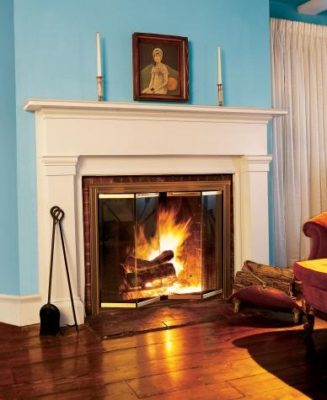
A cozy fire on a cold night is a delight. But a wood fire left untended isn’t safe. Unlike a gas fireplace, which can be switched off, the only way to leave a wood fire is closed off with glass doors. Retrofitting this safety feature to an existing fireplace isn’t difficult. The doors come in standard sizes that fit in any flat firebox opening. For full step-by-step instructions, see How to Install Glass Fireplace Doors.
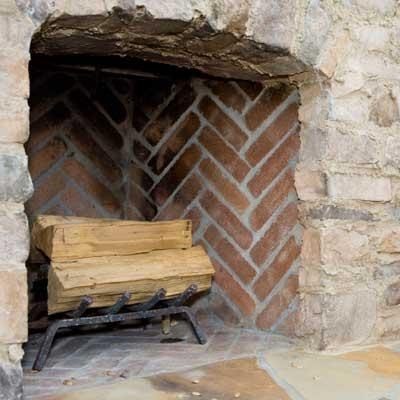
Get Your Firebrick in Shape
After years of searing-hot blazes, fireplace mortar can crack, crumble, and fall out. Gaping mortar joints are not only unattractive, they leave the bricks more vulnerable to damage. So before wood-burning season starts, examine the condition of the mortar in the firebox and take an hour or two to replace any that has deteriorated. See How to Get Your Firebrick in Shape for all the tools and steps you need to learn how to update your fireplace.
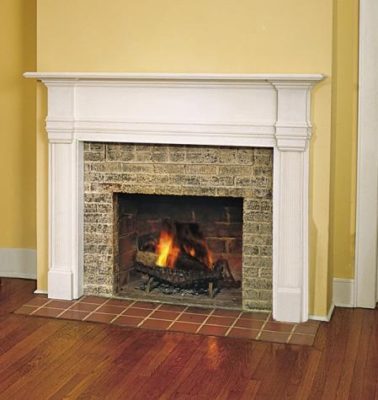
Install a Mantel
The stockings are hung by the chimney, but who cares? That mantel they’re strung from is a joke. Its boring profile may have looked pretty festive for holidays past, but we all know that sagging shelf’s barely fit to foot a mug of eggnog. The chimney is permanent, but the mantel’s just a front. Sharp, detailed models come in kits that lock together with a few twists of the Phillips-head. You can have a whole new look in less than a day. For full step-by-step instructions on how to update your fireplace, see How to Install A Mantel.
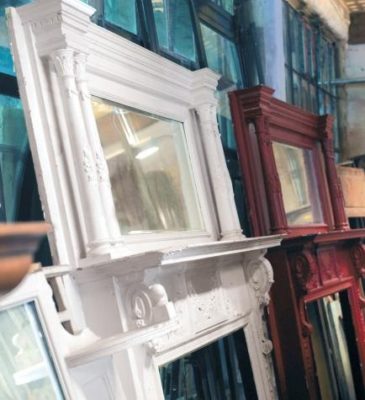
Opt for a Salvaged Mantel
The hearth has endured, in part, because of the wooden mantel that frames it. A mantel serves not only as an architectural anchor in a room but as a functional shelf on which to display prized possessions. That’s why so many of them still grace the parlors, dining rooms, and bedrooms of old houses even when the fireboxes have been walled over to eliminate drafts. For every surviving example, of course, there are dozens that were torn from walls during reckless remodels. Luckily, many discarded mantels have ended up at architectural salvage yards. See How to Choose a Salvage Mantel to learn how you can find and refurbish a find of your own.

Tile a Hearth
Why is it that the mantel always gets all the attention? Sure, it flaunts the grand shelf, the carved legs—it’s the frame around the flames. But mantels come and go. It’s the hearth that’s always been there, an ornate buffer between the fire and the shag rug. Consider jazzing things up with some colorful new tiles. You can change the whole look of a fireplace—and the room—in one or two weekends. For full step-by-step instructions, see How to Tile a Hearth.

Choose the Right Tiles
Designer tile is a great material for a hearth, but it isn’t always the appropriate one. Fortunately, there are many other masonry products that work well for fireplace decoration, from formal white marble to earthy terra-cotta, and they are all installed using the same methods in the How to Tile a Hearth project. The only limitation is that they must be able to stand the heat (and a dropped log every now and then). For a few stylish alternatives, see Tiles for the Hearth.
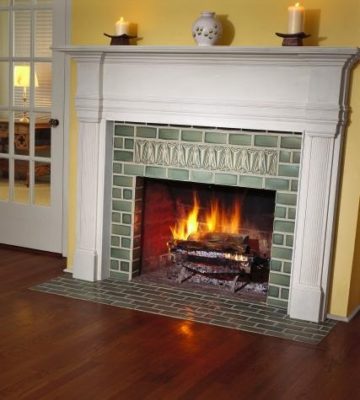
Tile the Surround
Nights by that old fireplace practically screamed for a glass of Chablis and the soothing sounds of Lionel Ritchie. Now you’re more about dinner parties and family holidays in front of the hearth. But before you go at old bricks with a paint roller and some white semigloss, consider the more elegant cover-up of art tiles. Tiling a fireplace surround isn’t a quickie makeover. But it’s well worth the effort. For full step-by-step instructions, see How to Tile a Fireplace Surround.

Choose the Right Tile for Your Surround
As a focal point, a fireplace can set the tone for the whole style of a room. Rough brick can pull a rustic space together, while smooth glass can be used to set a modern tone. For a few of our favored designs—sure to create an eye-catching centerpiece in any environment—see the TOH Fireplace Tile Buying Guide.
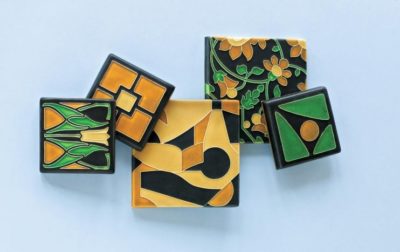
Consider Using Art Tile
The beauty of artisanal tile lies in its imperfections. Because each piece is designed, molded, and glazed by hand, no two look exactly alike. Use them as an accent with plain subway tile, or mix a handful in with monochromatic squares to make your fireplace surrounds spring to life. Inspired by early-20th-century styles, these low-relief polychrome tiles are made using the Spanish cuenca process, in which individual glazes are poured by hand into the depressions formed by raised lines in the clay. For more on these and other beautiful tiles, see The Art Tile Buying Guide.
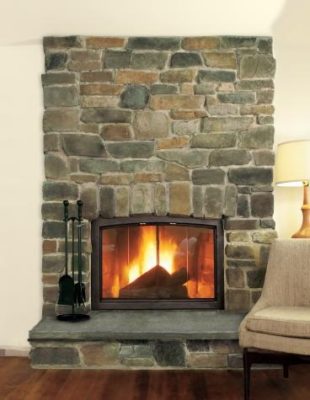
Build a Stone-Veneer Fireplace Surround
There’s something so homey about a stone fireplace, bringing to mind cozy nights spent with loved ones in front of a blazing hearth. Think using real stone is the only way to get this look? Think again. Today’s cast-stone veneer looks a lot like the real thing, with styles ranging from stacked stone to river rock. And if its nicer price tag makes it an option that’s hard to pass up, the DIY-friendly installation will seal the deal. For full step-by-step instructions, see How to Build a Stone-Veneer Fireplace Surround.

Add a Granite-Slab Surround and Swap Out the Mantel
Chipped bricks, a stained hearth, and years of accumulated soot can turn what should be the focal point of a living room into an eyesore. Replacing a hearth and surround—either with seamless tone slabs or with ceramic or stone tiles—makes a big difference in the way a fireplace looks. You can replace an old quarry-tile hearth and cover a brick surround with four sleek granite slabs, each 1¼ inches think. For full step-by-step instructions, see Fireplace Facelift.

Fireplace Design Ideas
On a cold night, an industrial drum filled with coals could be considered a beautiful fireplace. The trick is to create a fireplace that is art without a flame.
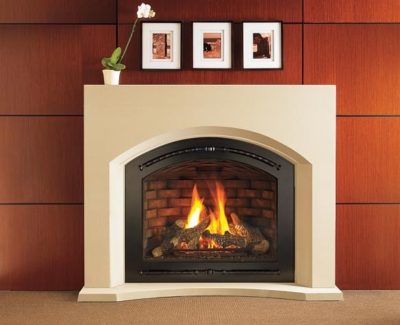
Add a Gas Fireplace
There’s only one thing better than a roaring fire on a wintry night: a roaring fire that needs no tending, requires minimal cleanup, and doesn’t leave the rest of the house freezing cold. That’s what you get with today’s gas fireplaces. Long gone are the anemic blue flames and unconvincing “logs.” Modern versions burn much more realistically, with glowing red embers and tall orange-yellow flames that dance and flicker around ceramic-fiber logs molded from the real thing. See All About Gas Fireplaces to find the right model for your home. Then, watch our How to Install a Gas Fireplace video for installation advice from the pros.
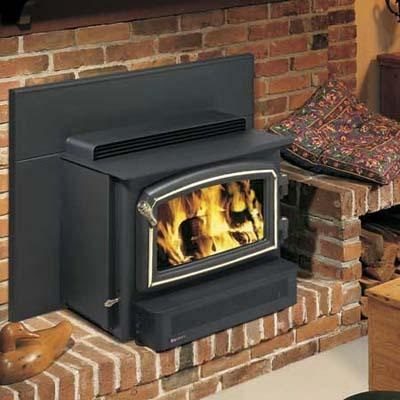
Put in a Fireplace Insert
Fireplaces rank among the top three features desired by new homebuyers. Unfortunately, fireplaces are also major air gaps—they can send up to 8 percent of valuable furnace-heated air flying out the chimney, making them really fun to look at but inefficient as heating sources. Here’s the good news: You can transform your firebox into an efficient room heater by adding an insert.
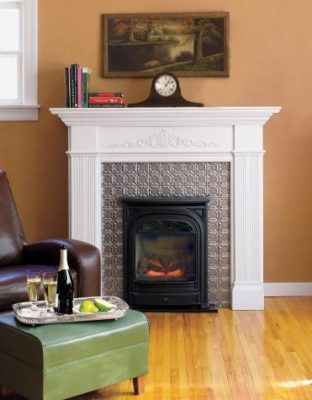
Add a Tin-Tile Fireplace Surround
While looking for a way to add personality to their new custom fireplace, Steve and Sandy Miller had this flash of genius: Why not use the same unique tin tiles that adorned their kitchen backsplash for the surround? In total, the project took only a few days—but the result will look cozy all winter.
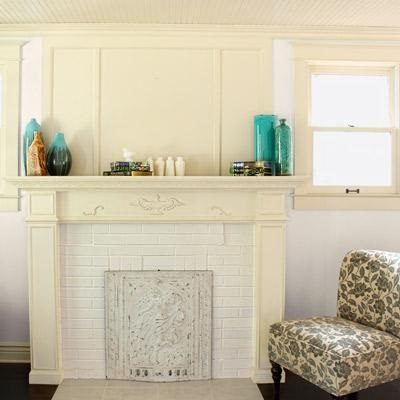
MDF Fireplace Face-Lift
The nonworking brick fireplace in John and Casey Spencer’s 1920s bungalow was more of an eyesore than an eye-catcher. It lacked a mantel, and hiring a carpenter to custom-build one was beyond the couple’s budget. Their solution? Make one using off-the-shelf supplies, like MDF, astragal molding and baseboard.
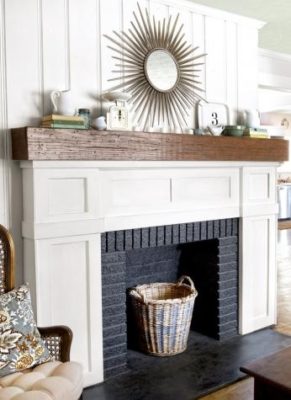
Cover a Mantel Shelf with Pine Boards
A fireplace should steal the show in a living room, not drag it down. At Kevin and Layla Palmer’s 1950s home, in Prattville, Alabama, the gathering space’s dreary gray fireplace was more homely than homey. And once the room’s knotty-pine walls got a much-needed coat of cream-colored paint and the wall-to-wall carpet was pulled up to reveal warm oak floors, the fireplace became even more of an eyesore.
Article by the editors of ThisOldHouse.com
Click here for the full article

